
Tipping points that could trigger catastrophic climate change via Wikimedia Commons.
The research presented during the EGU’s 2016 General Assembly have wide-reaching implications for how we understand planet Earth. In today’s post, Sara Mynott, an EGU press assistant during the conference, writes about findings presented at the meeting which highlight the importance of the biosphere when it comes to understanding the threat posed to our planet by environmental challenges.
With the climate changing, land use shifting and continued environmental pollution, something’s got to give. And if it does, it may well trigger catastrophic change. With so many threats to our planet’s integrity, making decisions about what environmental challenges we should tackle first is a challenge. This is why the Stockholm Resilience Centre created the planetary boundaries framework. The framework identifies key tipping points that could cause catastrophic climate change. Recent updates to the framework have identified biosphere integrity and climate change as two of the core planetary boundaries that, if crossed, could endanger human prosperity.
A lot of research has been done into the tipping points that could trigger catastrophic climate change, from large scale methane release to irreversible ice sheet melt, but one area remains profoundly overlooked. The biosphere.
“It’s very well known that the climate affects the biosphere and the biosphere affects the climate, but there’s still a large amount of uncertainty about how those two are going to interact and play out,” explains Steven Lade, a modeller at the Stockholm Resilience Centre.
Climate talks tend to focus around cutting CO2, but there is three times as much carbon stored in soils and vegetation than there is in the atmosphere, making the biosphere a major reservoir. By modelling interactions between the climate and the biosphere, Lade aims to find out whether biosphere degradation could trigger catastrophic climate change.
“There’s definitely enough carbon in the biosphere to cause catastrophic climate change. There’s no question about that. The question is how accessible it is, how rapidly it will be pumped out, how rapidly other feedbacks in the climate system might counteract that. The quantity is enough, but the speed and the feedbacks may help counteract that. This is why we’re trying to do a dynamical model.”

Just one small part of the biosphere. Credit: Paul
via Wikimedia Commons.
Rather than predicting where these boundaries lie, Lade is looking for things that could cause catastrophic feedbacks. This means his models are relatively simple – a way of finding out what happens when you push life to its limits.
“The point is to incorporate different assumptions about what people know, for example, about how the climate and biosphere interact and look at the consequences of those assumptions. To show, for example, whether the biosphere might be strong enough…if you stopped emitting more carbon, but degrade the biosphere heavily – could the resulting carbon emissions trigger catastrophic climate change?”
He aims to see whether those outcomes are plausible or not. It’s an interesting approach, one that will help shape decisions about we can prevent catastrophic change and let policy be put into practice.
By Sara Mynott
Sara is a science writer and marine science PhD candidate from the University of Exeter. She’s investigating the impact of climate change on predator-prey relationships in the ocean, and was one of our Press Assistants this year’s General Assembly.



